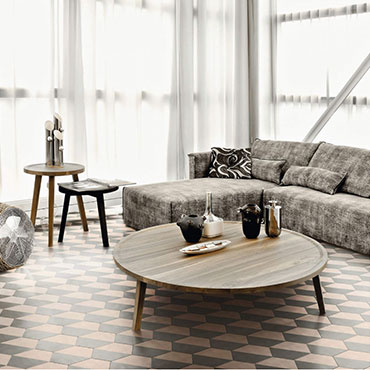Bisazza is one of the top luxury brands in the design sector and the industry’s leading producer of glass mosaics for interior and exterior decoration. Over the past few years, the company has extended its decorative offerings with new materials made through processes that combine the value of design with the charm of craftsmanship. Learn More
Hand-Made and Handcrafted Tile
Hand-Made and Handcrafted Tile Guide

Reviving Tradition in Modern Spaces: The Timeless Appeal of Hand-Made Tile Flooring
Introduction
Hand-made or handcrafted tile flooring, an ancient art form, has seamlessly transitioned into modern architecture and interior design, offering a unique blend of historical significance and contemporary flair. Tracing its roots back to ancient civilizations, this type of flooring has evolved from a functional element to an emblem of artistic expression and environmental consciousness.
Defining Hand-Made, Handcrafted Tile
In the realm of flooring, hand-made and handcrafted tiles are distinct for their individuality and craftsmanship. Each tile is meticulously shaped, glazed, and fired, often in small batches, resulting in a product that is not just a piece of flooring but a work of art.
Material Properties and Sustainability
These tiles are celebrated for their durability and resistance to wear and tear, standing the test of time both in aesthetics and functionality. Their low maintenance needs make them a practical choice for various settings. From an ecological standpoint, these tiles often utilize energy-efficient production methods and are made from natural, recyclable materials, making them a favorite in green building projects.
Design Versatility and Aesthetics
The bespoke nature of hand-made tiles offers a vast spectrum of colors, patterns, sizes, and finishes, enabling architects and designers to create personalized and unique design narratives. This versatility allows these tiles to adapt to and enhance various architectural styles, from rustic to contemporary.
Technical Advancements
Technological innovations in the manufacturing of hand-made tiles have opened new horizons in customization and design. Advanced kiln technologies and glazing techniques have broadened the scope for experimentation, allowing for more intricate designs and durable finishes.
Application Diversity
Hand-made tiles are not just limited to residential spaces; their application spans across commercial, healthcare , and hospitality sectors. Innovative uses in various projects, from accent walls in boutique hotels to statement flooring in high-end residences, showcase their adaptability and aesthetic appeal.
Performance and Functionality
Apart from their visual allure, these tiles offer practical benefits. Their water resistance and antibacterial properties make them ideal for hygiene-sensitive environments like kitchens and bathrooms. The durability also makes them suitable for high-traffic areas in commercial or public spaces.
Sustainability and Environmental Impact
In the context of sustainable building practices, hand-made tiles contribute significantly. Their production often involves environmentally friendly practices, and they play a role in achieving LEED certification and other environmental standards. Their natural composition and manufacturing process also ensure a reduced environmental and health impact.
Cultural and Artistic Significance
Hand-made tiles carry a cultural narrative, with different regions around the world having their unique styles and methods. Contemporary designers are increasingly using these tiles to merge traditional craftsmanship with modern design, creating spaces that are both culturally rich and aesthetically modern.
Cost-Effectiveness and Long-Term Value
While the initial cost may be higher compared to mass-produced tiles, the long-term value of hand-made tiles lies in their durability and timeless appeal. When compared to other materials, they often emerge as a more advantageous choice, especially in spaces where quality and character are paramount.
Conclusion
Hand-made tile flooring is more than just a design choice; it's a statement of quality, sustainability, and artistic expression. Its role in shaping future trends in architecture and interior design is undeniable. Architects, interior designers, and facility managers are encouraged to explore the innovative potential of these tiles in their projects, embracing their ability to blend tradition with modernity and create spaces that are both functional and aesthetically compelling.
Disclaimer: The information provided in this article is for general informational purposes only. While we strive to ensure the accuracy and reliability of the information presented, we make no warranties, express or implied, about the completeness, accuracy, reliability, suitability, or availability with respect to the content. Any reliance you place on such information is strictly at your own risk. We recommend consulting with professionals for specific advice tailored to your project’s needs, particularly regarding building codes, regulations, and product specifications.
Under no circumstances shall we be liable for any loss or damage, including without limitation, indirect or consequential loss or damage, arising from the use of, or reliance on, the information provided in this article.
Featured Brands
The Best 2 Hand-Made and Handcrafted Tile Brands

Bisazza Tiles
Profile | WebsiteBisazza is one of the top luxury brands in the design sector and the industry’s leading producer of glass mosaics for interior and exterior decoration. Over the past few years, the company has extended its decorative offerings with new materials made through processes that combine the value of design with the charm of craftsmanship. Learn More

Lunada Bay Tile
Profile | WebsiteLunada Bay Tile creates handcrafted glass, ceramic and concrete tiles with an emphasis on simplicity, texture and color. Learn More
